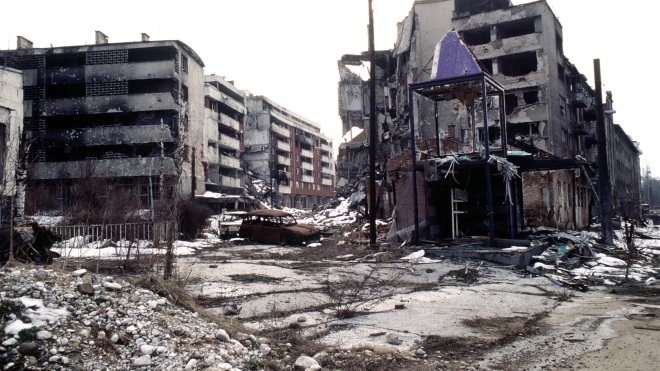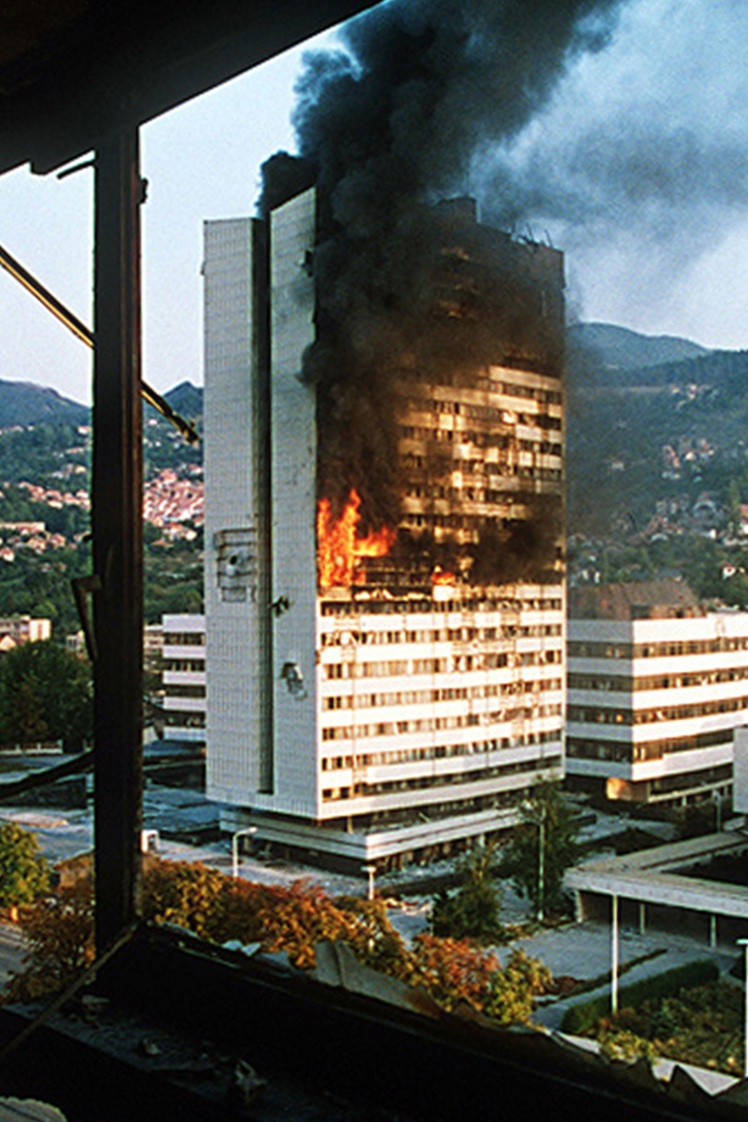The breakup of Yugoslavia and the beginning of the siege
The breakup of Yugoslavia actually began on June 25, 1991, when Croatia and Slovenia simultaneously declared independence. Subsequently, Bosnia and Herzegovina did the same — on October 15, 1991, a declaration of sovereignty was issued, and in a referendum in February 1992, the majority of the population voted for independence.
It led to wars everywhere. Slovenes fought for their independence for 10 days, Croats and Bosniaks way longer — until 1995. The scenario of the wars was similar. At that time, only Serbia and Montenegro remained from the former Yugoslavia. Croatia and Bosnia had large Serb populations that ignored the referendums and protested against independence. The Yugoslav Peopleʼs Army (YNA) mostly consisted of Serbs, so most of it also opposed the independence of these countries. The situation was complicated by the fact that the peoples of Yugoslavia had different religions: the Serbs were Orthodox Christian, the Croats were Catholics, and the Bosniaks were Muslims.
A government building in central Sarajevo burns after being hit by a tank during a siege in 1992. The Yugobank building during the siege of Sarajevo, winter 1992-1993.
Wikimedia
A separatist government of the Republika Srpska was formed on the territory of Bosnia. It held the referendum to remain part of Yugoslavia. This government was supported by the remnants of the YNA and by Serbia, led by President Slobodan Milošević. In March 1992, the first armed conflicts between Serbs and Bosniaks, who were supported by local Croats, began in Sarajevo. The first armed conflict took place on March 1: a gunman opened fire on a Serbian wedding procession, killing two people. Barricades began to be erected in the city — they separated the Serbian and Bosnian districts.
On April 2, the Serbs tried to seize power in Bosnia: their roadblocks and barricades appeared near the parliament building, and snipers were also stationed. Many thousands of city residents came out in a peaceful demonstration to drive the Serbs out of the city center. They started daily rallies. On April 5, at the demonstration, snipers shot two women — Suada Dilberović and Olga Sučić. They are considered the first victims of the siege. For all this time, shootings and skirmishes continued in the suburbs of Sarajevo.
On April 6, 1992, Bosniaʼs independence was recognized by the EU countries, and the next day by the USA. The President of Bosnia and Herzegovina, Alija Izetbegović, announced mobilization, Bosnian fighters formed the Territorial Defense. The Serbian separatist government called on the Serbs to leave Sarajevo, and units of the Yugoslav army surrounded the city.
On May 2, the Serbs broke through and tried to split Sarajevo in half, but the attack was repulsed. The parties concluded an agreement on the safe withdrawal of the last YNA units from the city, but the Bosnian defenders fired on the Serb column. They had to negotiate again. On May 20, Serbian forces left most of Sarajevo, and the Bosnian government declared them an occupying army. At the same time, the YNA was officially disbanded — only Serbs remained in it, so it became the Serbian army. The siege of the city began — the Serbs blocked the entrance to the city and started shelling.
Sarajevoʼs siege in 1992 — 1995. Red is Serbian territory, the blue line is the Snipers Alley, the white line is the Sarajevo tunnel
«Babel'»
Sarajevo Tunnel, Sniper Alley, and Holiday Inn Hotel
From the beginning of the siege, the situation in the city was difficult — the Serbs controlled not only almost all the suburbs but also several areas of Sarajevo with the most convenient positions for shelling — on the hills and in high-rise buildings.
Dragon of Bosnia Street is one of the main streets in the city, it goes from the center to the industrial areas. During the siege, the adjacent quarters were occupied by the Serbs. They constantly shelled this street, which is why it got the name "Sniper Alley" — until 1995, snipers wounded 1,030 and killed 225 citizens on it.
One of the many warning signs in Sarajevo, Pazi Snajper means "Watch out, sniper".
Wikimedia
For some Serbian soldiers and foreign mercenaries, sniping on Dragon of Bosnia Street became entertainment and "military tourism". Russian writer Eduard Limonov came to Bosnia, on June 22, 1992, he was filmed firing a sniper rifle at the surrounded city. Next to him was the President of the Republika Srpska, Radovan Karadžić. In general, according to the Hague Tribunal, there were 529 to 614 mercenaries from Russia, Greece, and Romania in the ranks of the Bosnian Serb army. The Russians also participated in the shelling of Sarajevo.
Dragon of Bosnia Street led to the airport, so foreign journalists who wanted to get to Sarajevo had to pass through it. On July 23, 1992, CNN cameraman Margaret Mott came under fire, a bullet hit her in the face. In six months, she returned to Sarajevo and joked that she had come to find her lost teeth. And on August 13, 1992, a sniper killed ABC News producer David Kaplan.
Despite this, journalists continued to arrive in the city. Some of them settled in the Holiday Inn hotel, on the same Sniper Alley. It was from this hotel that snipers opened fire on the demonstration in April 1992. When the Serbian army withdrew from the city, it became a target.
By that time, some of the rooms had already been crushed and burned during clashes and shelling. Residents were put in rooms without a view of the mountains, where the snipers were sitting. A simple rule applied: if you can see him, he can see you. At the same time, the hotel had a restaurant and an underground parking lot where people could hide vehicles.
It was possible to get to the city not only through the airport. The Serbs cut Sarajevo off from other Bosnian territories, and by early 1993 the capital was running out of food and ammunition. Therefore, on March 1 of the same year, the Bosnian army began to build a tunnel from the airport to the Serbs-free territories. The project was developed by engineer Nedžad Branković.
The tunnel began to be dug from two sides — from Sarajevo and from Butmir, where the Bosnian troops were stationed. It started working already on July 1. Its length reached 840 meters, a 340-meter section passed under the runway of the airport and had access to the basement of a private house, the other part was a covered trench. At the lowest point, its depth reached 5 meters. Every day, 3-4 thousand people — military and civilians, and 30 tons of cargo — weapons and supplies — passed through this tunnel. Later, power lines and even a small oil pipeline were laid through it.
UN peacekeepers, who since June 5, 1992, have been monitoring security at the Sarajevo airport, helped protect the tunnel. They also regularly used the tunnel when they had to leave the siege zone.
A UN peacekeeper from Norway holds on to his helmet as a Hercules C-130 transport plane lands at Sarajevo Airport in the summer of 1992.
Wikimedia
Markale market, town hall, and "Sarajevo roses"
Sarajevo was shelled not only by snipers — from time to time the Serbs used artillery. Most often these were 120-mm mortars, but they also did not disdain heavy artillery — fired from 155-mm M-1 howitzers, 152-mm Nora and D-20 howitzers, 120-mm Soviet D-30 and 2S1 Gvozdika, M63 Plamen and M77 Oganj multiple rocket systems.
From 1992 to 1995, an average of 329 shells per day hit the city. The heaviest fire was on July 22, 1993, when 3,777 shells were fired at Sarajevo. By September 1993, almost all buildings in the city were damaged, and 35 thousand houses were completely destroyed.
Cellist Vedran Smailović plays in the destroyed library of the city hall, 1992.
Wikimedia
During the shelling on August 25, 1992, the Serbs destroyed the Sarajevo town hall — Vječnica, which was built in 1894. Ancient manuscripts and books, a total of one and a half million different paper editions, were stored in the town hall. Most of the books were burned during the fire, but some were saved by the townspeople — for this, they threw themselves into the flames. One of the rescuers was shot dead by a sniper.
In 1994, artillery shelling of civilian objects in the city became particularly deadly. On February 4, a Serbian mine killed 10 townspeople who were standing in line for water. The next day, one high-explosive mine hit the city market of Markale, where there were many people at the time — 68 Sarajevo residents were killed and more than 200 were injured. The UN investigation established that the mine was launched from Serbian positions near the village of Mrkovići, 6.2 kilometers north of Sarajevo.
Residents of Sarajevo stand in line for water, 1992.
Wikimedia
On August 28, 1995, Markale market was shelled again. This time, five mines fell on it at once, but the number of victims was fewer — 43 dead, 81 wounded. The mines were launched from the Lukavytsi district, 3-5 kilometers south of the city.
After the siege, holes from mines and shells on the roads of Sarajevo were filled not with new asphalt, but with resin, plastic, and red paint. Such small memorials are called "Sarajevo roses", there were about two hundred of them in the city, but some have already disappeared due to road repairs.
"Sarajevo Rose".
Wikimedia
What happened next?
After the first shelling of the Markale market, NATO issued an ultimatum to the Serbs — to stop bombing the city and withdraw heavy equipment 20 kilometers from its borders. Karadžić ignored these demands. When the shelling was repeated, the NATO command announced the start of the military operation "Deliberate Force".
An F-16 lands at Italyʼs Aviano Air Base after NATO airstrikes against Republika Srpska.
Wikimedia
From August to September 1995, NATO aircraft destroyed almost the entire military infrastructure of the Republika Srpska army and forced the siege of Sarajevo to be lifted. The Serbs agreed to sit down at the negotiating table.
On December 14, 1995, the USA concluded the Dayton Accords. Serbian President Slobodan Milošević signed them on behalf of the Serbs. According to these agreements, the Republika Srpska remained part of Bosnia and Herzegovina. Democratic elections were scheduled for 1996, and the post of the president became collective — the country is still governed by a presidium of three presidents: one each from Serbs, Croats, and Bosniaks.
During the siege of Sarajevo, 5,434 civilians died — 3,855 Bosniaks, 1,097 Serbs, and 482 Croats.
Cemetery on the territory of the Olympic sports complex in Sarajevo, which was built for the 1984 Winter Olympic Games.
Wikimedia
Translated from Ukrainian by Olya Panchenko.
Details of war crimes are known only thanks to the work of independent journalists. Support “Babel”: donate in hryvnia 🔸 in cryptocurrency 🔸 Patreon 🔸 PayPal: [email protected]


